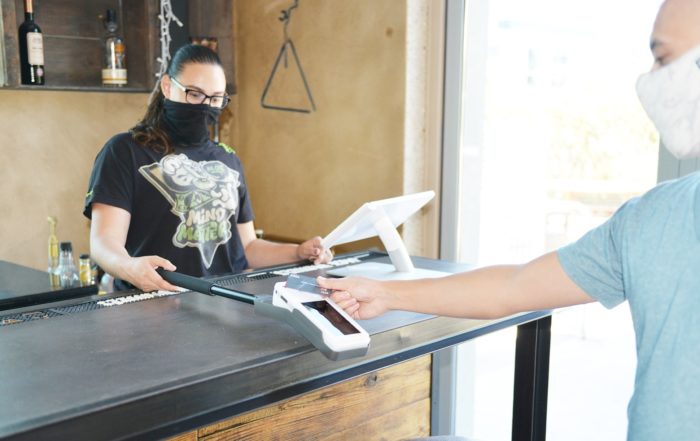Point of Sale terminals are electronic devices that are used for verifying and processing debit and credit card transactions. Consider the rapid influx of point of sale terminals in our day-to-day lives by comparing how many times per day you utilize one versus say a decade ago…or how about two decades ago!? Point of sale terminals are often incorporated into a Point of Sale System (POS System) which is a computerized network operated by a main computer and linked to several checkout terminals. Point of sale terminals have become the indispensable equipment in everyday business transactions, regardless of size. Today’s point of sale terminals are faster and more reliable than their predecessors with convenient new capabilities including contactless and Mobile payment acceptance.
The Evolution of POS Industry
The first Point of Sale Systems were implemented by IBM in the 1970s. Early terminals had no processing capability; the set-up was standard for businesses that were transitioning to a “computer” based system. The Pathmark supermarket in New York and New Jersey and the Dillards department stores in California were two of the early adopters of the POS technology.
It wasn’t until the beginning of the 1990s that the idea of personal computers running software could automate the functionality of a retail store. This is when hardware became capable of running software programs that had rich functionality and an intuitive graphical user interface. The original POS system was actually developed by a New Yorker named Gene Moshel on an Apple computer in 1978. Today, there are hundreds of software vendors making software for POS. The software runs on all types of machines and different operating systems. Large businesses run via a client server model in which there is a dedicated server, which all the other stations talk to for retrieving and storing data.
POS terminals emerged in 1979, when Visa introduced a bulky electronic data capturing terminal. This was the first of credit card terminals as we know today, and it greatly reduced the time required processing a credit card. In the same year, MasterCharge became MasterCard and credit cards were replaced to include a magnetic information stripe. In 1981 the company known as VeriFone had its first order of 200 terminals from Tymshare. In 1983 VeriFone introduced the ZON terminal which set the standard for all credit card terminals. ZON terminals led the way for the Tranz series terminals and later the Omni series terminals from VeriFone. To this day, VeriFone has maintained their line of best selling terminals in the world. VeriFone is the largest manufacturer of processing terminals in the world.
In the 80s, credit card holders would rely on the manual imprinters to process a transaction. Originally, merchants would imprint their customers’ cards and then mail their slips to their bank. This process was both time consuming and slow. The proliferation of point of sale terminals as we recognize them today started to truly take off in the early 2000’s and MONEXgroup was a pioneer at the forefront of offering the advanced payment technology.
How the Point of Sale (POS) Industry Works
Point of Sales systems include a synthesis of both hardware and software, and coming up with the right blend for a particular business model is no simple matter. As a rule of thumb, the Point-of-Sales industry starts off with the actual machine, which requires a manufacture to create the hardware.
Step 1: Incorporating the Point of Sale terminals into a POS System
POS systems include POS terminals, bar code scanners, keyboards, cash drawers, pole displays, and receipt printers. POS software developers focus on creating software that provides POS functionality such as sales transactions, reporting capabilities, managing customer data, and so on. It is common for developers to customize their POS software for various industries, such as retail, grocery, liquor stores, salons, and others, since business types can vary in needs. Some software developers choose to work directly with businesses to create cost-effective and customized solutions, without the distributor part of the process. Some developers focus on providing online POS solutions based on cloud technology, so that the point of sale software can be used more independently of hardware restrictions, and accessed from a POS station, computer, laptop, or Smartphone (POS Industry).
Step 2: POS Distributors
POS distributors act as liaisons between manufacturers and VARs (Value-Added Resellers). By working with manufacturers, the distributors help to reduce costs, and improve products with product testing and product support. POS distributors also are able to integrate POS hardware with various POS software options, allowing VARs to offer reasonable options for businesses of all levels.
Distributors offer several benefits to the re-sellers which may include training for products, sales support and education. They can also provide technical support, such as testing software compatibility with POS terminals, as well access to an extensive inventory. Distributors also provide a credit facility, when VARs require it, to allow sales involving large amounts of equipment to be easily transacted.
Step 3: Value-Added Resellers (VARs)
POS VARs are specialists who work directly with business owners to find the right blend of hardware and software for their business, they also aim to add value with their expertise and provide ongoing support. VARs may work independently or with a POS Distributor. VARs will handle installations, coordinating or supervising cable and electrical installations. They will also provide on-site training for the staff.
Step 4: POS End-Users (Businesses)
The End-Users of POS systems are essentially large and small businesses ranging in retail, service and other industries. Businesses using point of sale terminals within POS systems can range from store retailers to E-Commerce, to national or international corporations. Integrated point of sale terminals can have tremendous benefits for apparel or hospitality applications, automotive shops, drug stores, restaurants, grocery stores, E-Commerce, and more. Having a network of integrated point of sale terminals saves time and money, effectively increasing efficiency and improving customer service plus overall satisfaction.
Top 5 Mistakes to Avoid when Choosing Point of Sale terminals
If you are a business owner, you should avoid these top 5 mistakes in choosing the right and best point of sale terminals for your business. At the end of the day, when you employ the right point of sale terminals and solutions, it will be an important key to your business’ success.
- Not Understanding/Researching Your POS Needs
- Insufficient Training
- Buying Solely on Price
- Purchasing an Outdated System
- Choosing the Wrong Partner for Merchant Services
Influence of POS systems on Retail Business
Industry Performance Summary
The POS industry is undergoing a period of consolidation as larger industry players look to increase market share through acquisition. Advancements in technology have contributed to drastic changes in the industry and these factors have helped to stimulate sales and innovation in the POS industry.
Technology Impact
The wider adoption of both mobile and cloud computing systems put pressure on industry operators to create Retail and POS software that incorporates traditional, web-based, and mobile platforms. Other new technology developments in Retail include countertop POS terminals that have software for mobile devices that are enabled with near field communications (NFC). NFC-enabled devices allow consumers to store credit card and loyalty information on their mobile phones.
What are the benefits of partnering with MONEXgroup on Point of Sale terminals and Solutions?
MONEXgroup’s payment processing solutions are facilitated via an EMV & PCI compliant terminal communicating with an approved third party POS System. The ECRi (Electronic Cash Register Interface) integration allows merchants to securely process Debit and Credit card transactions at a consistently rapid speed with absolute accuracy. Integrated Payment Solutions provide the business owner with greater visibility into finances, inventory and operations management. At MONEXgroup, we always take the time to recommend and demonstrate the most ideal and compatible point of sale terminals for our merchants’ business needs. For example, if a merchant runs a physical store such as a spa, clothing store, or hair salon – we suggest the Clover Mini, which is an all-in-one payment terminal that comes with many advantages. If your business is a restaurant, bar, nightclub, or you run a delivery service or work outside as a contractor then you want to use the Clover’s on-the-go flex terminal which operates on both WiFi and LTE networks. But it’s not all about the point of sale terminals – it is the outstanding level of service that separates MONEXgroup from other payment processing providers.
When partnering with the number one payment processor in Canada; MONEXgroup will increase your efficiency and quality of service and lower the related costs. Request a Cost Comparison Analysis today.
Author: Lindsey Lu, Marketing Communication Specialist, MONEXgroup
Contact Info: insights@monexgroup.com
Jumpstart your business potential now with MONEXgroup
Get a Free Quote
MONEXgroup Insights
MONEXgroup Insights provides all the tools and resources you need to start, run and grow your business.
The Future of EV Charging Payment Solutions
Adoption of electric vehicles in Canada is growing, partly due to the ever-growing importance of eco-friendly solutions across all aspects of life, but also because access to EV charging stations is rapidly increasing. Another
Secure Healthcare Payment Processing & Medical Payment Data Security
The protection of sensitive information is certainly a major concern for businesses of all types, but in the medical and healthcare industry it is absolutely critical. Companies involved in healthcare must invest in the necessary
Contactless Payment Systems vs. Mobile Payment Technology: What Are They and How Can They Benefit Your Business?
In the last several years, the use of contactless payment systems and mobile payment technology has skyrocketed. With the arrival of COVID-19 in 2020, that use has continued to grow, as businesses and customers



